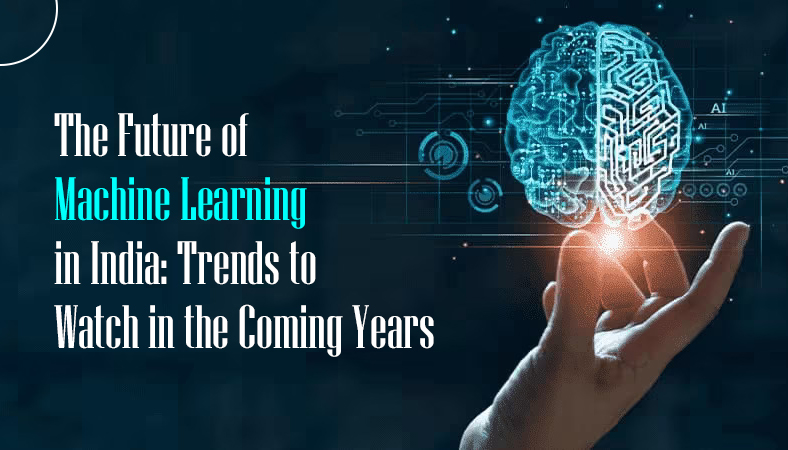Machine Learning (ML) has been the most advanced technology of the 21st century. From self-driving cars and personalized suggestions to crime prediction and disease diagnosis, ML is revolutionizing sectors around the globe. India, boasting its booming startup ecosystem and huge talent pool, is well-positioned to make a significant impact here.
In the next two years, some of the biggest trends about the machine learning development services in India will decide the destiny of machine learning in India.
1. Democratization of Machine Learning
Democratization of ML is probably the most thrilling trend. ML was previously the domain of research organizations and affluent organizations with deep pockets and big machinery. But low-code and no-code platforms have been reversing the script. AutoML, cloud ML as per the experts of machine learning development company India platforms, and open-source libraries have been making machine learning accessible to startup companies, small and medium enterprises, and even non-technocrats. Democratization will see even more industries—education and agriculture, manufacturing and retail—embracing ML and finding new means of growing and innovating.
2. Responsible AI Focus
As machine learning technology is used in ever more critical decision-making, ethical and responsible AI are in greater demand than ever.
This is catching up in India as well with the government, research centres, and private industry driving very aggressively on fairness, explainability, and accountability. Getting ML models to break the cycle of causing bias in hiring, lending, or policing, to quote a few, is now right at the top of the agenda. Future innovation will be highly likely to invest more in explainable models and tools that can avoid adverse side effects.
3. Convergence of 5G and IoT
Indian 5G network integration will also introduce a whole new set of innovations, the largest of which will be combining the Internet of Things (IoT) and Machine Learning (ML).
Faster speeds and reduced latency will enable devices to gather and analyze enormous amounts of real-time data and power intelligent cities, self-driving cars, and factory robots. Machine learning functions will be executed more frequently on the edge—on network or device edge—shoving the data to be sent to a distant central server. This will enhance privacy, decrease latency, and support real-time decision-making across healthcare, transportation, and agriculture.
4. ML Development in Healthcare
The deficit of physicians also negatively impacts the Indian healthcare sector, particularly in rural parts of the country.
Machine learning is the opposite, as it can expedite diagnosis, tailor treatment protocols, and deliver predictive analytics. For example, ML-based software can assist radiologists in identifying tuberculosis, cancer, and diabetic retinopathy with extremely high levels of accuracy. Wearables and mobile health apps can capture patient information, which, once processed using ML algorithms, can lead to active disease management and tracking of health. With more funding in health tech, ML will be a key driver of improved healthcare access and quality in India.
Related Post: Business Benefits of Artificial Intelligence (AI)
5. Personalized Education and EdTech
The education sector in India is becoming digitized quickly in the wake of the pandemic. At its core, the change is driven by machine learning, which allows individualized learning experiences to be provided to students with varying abilities. The adaptive learning technology can read a student's performance and reorganize content according to his or her individual needs so that they learn on their own terms.
Teachers can use ML to identify poor students and recommend ways through which learning can be improved by students. With India having huge and heterogeneous student groups, EdTech products based on the technology of ML will contribute the largest portion to fulfilling education needs and providing good-quality education.
6. Precision Farming and Agriculture
Agriculture supports the Indian economy, where half the population of the country is engaged.
Machine learning can revolutionize this sector with precision agriculture, which will adjust inputs such as water, pesticides, and fertilizer based on real-time feedback. Satellite images, maps of soil, and climatic patterns could be analyzed by machine learning algorithms to offer actionable intelligence to farmers with better returns and lower costs. Additionally, ML can automate supply chain management through improved price forecasting and minimizing post-harvest losses. With increasing private and government funding in agri-tech, ML-based applications in agriculture can only increase.
Related Post: The Top 5 AI Trends for Developers
7. Natural Language Processing and Regional Languages
India's linguistic diversity offers a golden opportunity to develop Natural Language Processing (NLP) models for Indian languages.
With more than 20 official languages and many other dialects, it is of the highest priority to develop ML systems with the capability to understand and process the languages to enable inclusive digital transformation. NLP advancements supported through deep learning will enable us to deliver more accurate translation, sentiment analysis, and conversational AI for local languages to enable more citizens to access digital services. This will enable the government's Digital India mission to level the playing field and empower Indian citizens.
8. AI Startups and Innovation Hubs Growth
Unprecedented innovation in AI and machine learning has taken place in the entire Indian startup ecosystem.
Bengaluru, Hyderabad, and Pune have become AI start-up hubs with solutions for all directions of problems—either finance and healthcare or entertainment and logistics. The government schemes under the guise of the Atal Innovation Mission and Startup India are placing bets in the ecosystem, offering incubators, and including programs of mentorship. We can be optimistic about a deep-tech start-up boom riding ML for fundamentally Indian problems in the near term and making the world AI ecosystem richer in the process.
Conclusion
The future of machine learning in India is rosy and hunky-dory. With technology progressing further, India has a great chance to harness ML to gain economic growth, social development, and international competitiveness. From making ML technologies more democratic in access and giving transparency to AI to 5G, IoT, and NLP for Indian languages, the above are an offer of machine learning's transformative potential in India. With these trends, India can capitalize on ML to tackle India's biggest challenges and create an innovation-led, inclusive, and sustainable future.




